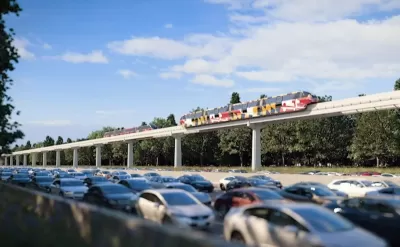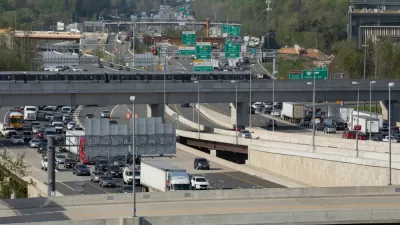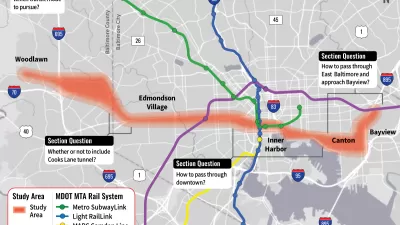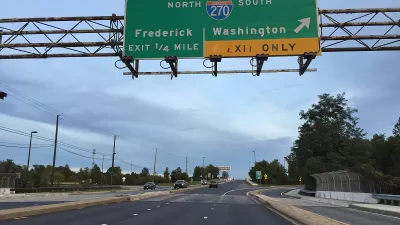The MDOT study found that the monorail line would draw many of its riders from existing public transit systems.

A recent study by the Maryland Department of Transportation (MDOT) found that a proposed monorail line would be a "viable" but not optimal option for reducing traffic on the Interstate 270 corridor. "The corridor," reports Katherine Shaver in the Washington Post, "is Montgomery’s hub for biotech companies, and the highway carries commuters between more affordable homes in farther-out suburbs and jobs in Montgomery, Washington and Northern Virginia."
The $4.4-billion monorail project would cut the 28-mile trip between Frederick and the Shady Grove Metro station to 42-46 minutes, but the study projects that one fifth to one third of riders would come from other transit systems rather than from private vehicles. "More development would have to be clustered around potential station sites to generate ridership, and motorists would need a 'behavioral shift' to switch to mass transit, the study said."
Proponents of the monorail argue that the study's ridership estimates are too conservative and that, if funded, the project would nevertheless be a positive step toward more efficient public transit in the region. "MDOT spokeswoman Erin Henson said the agency will seek feedback on the feasibility study from Montgomery and Frederick counties and see whether either includes a monorail in its annual letter, expected this spring, outlining local transportation funding priorities."
FULL STORY: Monorail is a ‘viable’ transit option for I-270 but wouldn’t reduce traffic, study says

Planetizen Federal Action Tracker
A weekly monitor of how Trump’s orders and actions are impacting planners and planning in America.

Map: Where Senate Republicans Want to Sell Your Public Lands
For public land advocates, the Senate Republicans’ proposal to sell millions of acres of public land in the West is “the biggest fight of their careers.”

Restaurant Patios Were a Pandemic Win — Why Were They so Hard to Keep?
Social distancing requirements and changes in travel patterns prompted cities to pilot new uses for street and sidewalk space. Then it got complicated.

Platform Pilsner: Vancouver Transit Agency Releases... a Beer?
TransLink will receive a portion of every sale of the four-pack.

Toronto Weighs Cheaper Transit, Parking Hikes for Major Events
Special event rates would take effect during large festivals, sports games and concerts to ‘discourage driving, manage congestion and free up space for transit.”

Berlin to Consider Car-Free Zone Larger Than Manhattan
The area bound by the 22-mile Ringbahn would still allow 12 uses of a private automobile per year per person, and several other exemptions.
Urban Design for Planners 1: Software Tools
This six-course series explores essential urban design concepts using open source software and equips planners with the tools they need to participate fully in the urban design process.
Planning for Universal Design
Learn the tools for implementing Universal Design in planning regulations.
Heyer Gruel & Associates PA
JM Goldson LLC
Custer County Colorado
City of Camden Redevelopment Agency
City of Astoria
Transportation Research & Education Center (TREC) at Portland State University
Camden Redevelopment Agency
City of Claremont
Municipality of Princeton (NJ)





























